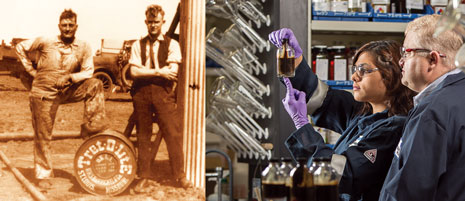Innovative thinkers
Tret-O-Lite: 100 years of refinement
|
Although today’s producers are still trying to find the most effective way to separate what comes out of the well into useable and non-usable components, the situation looked much more grim at the turn of the 20th century. At a time when filling earthen pits with oil mixtures that could not be commercialized was the best-possible alternative to the burning of off-spec oil, early field operators were keen to find a safe solution that would both maximize their production, and limit the potential environmental nightmare on their hands. If the methods used to extract oil during the early 1900s seem crude in retrospect, consider the quality of what producers encountered once they brought liquids to the surface. With the key perpetrator being water, sediments like salt and other debris were also often intermixed, and rendered much of what was produced, referred to as “roily” oil, useless. A combination of compelling factors converged in the pre-World World I era, during which time William S. Barnickel made the first, most important, steps toward helping to solve one of the oil field’s peskiest problems. According to Mark Williams, a senior applications advisor with Baker Hughes, the first commercial chemical demulsifier product, Tret-O-Lite, was patented by Barnickel in response to the need for fuel for Henry Ford’s booming car production and by the high demand for oil during the world’s first mechanized war. It was in this chaotic atmosphere that Barnickel positioned himself, using a doctorate-level pharmacy degree, and an “absolute, relentless pursuit of science,” to identify emulsions, and how to resolve them. He, too, was bothered by the burning oil pools popping up across Kansas and Oklahoma. Not only was Barnickel interested in perfecting the balance of chemicals needed to separate oil from much-unwanted contaminants, but he also realized the importance of the business applications for such a process. In the early 1910s, he, in partnership with attorney Jack Leh- Soon after receiving a patent, Barnickel faced infringement issues and struggled to receive payment for his services, even going to court. This was all while the newly patented demulsifier was still being blended in the field, with whatever raw materials could be sourced locally from Texas, Oklahoma or Louisiana. Barnickel was able to open a proper plant, housed in an old warehouse in St. Louis, in 1914, and followed that with a larger space outside of the city soon after, enabling real, commercial production of their chemical blend. By 1922, almost 11,000 drums of demulsifier were produced that enabled approximately 50 MMbbl of roily oil to be recovered. Barnickel, who would often sleep in a tent next to treating vessels, “in essence worked himself to death,” dying in 1923 and being succeeded by legendary inventor and patent-holder Melvin DeGroote, who was educated at Carnegie Mellon Institute. DeGroote improved significantly upon the demulsification chemistry at the heart of Barnickel’s original formula. Through the innovations of both Barnickel and DeGroote, and of countless other individuals and teams since, the process pioneered on the early Midwestern oil scene is now celebrating its 100th anniversary. One hundred years later, Tret-O-Lite fluids separation technologies have grown in use to include application for any crude composition.
|



